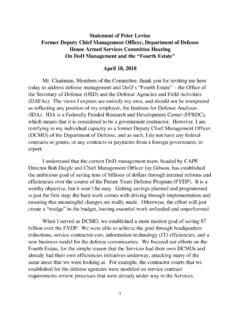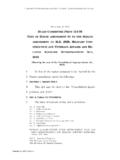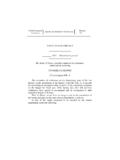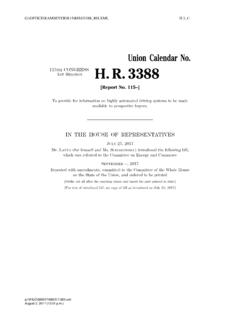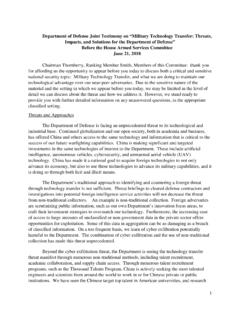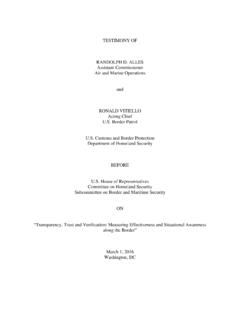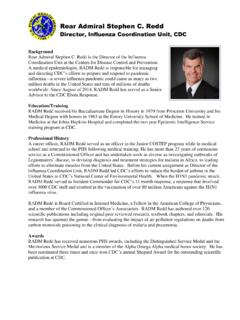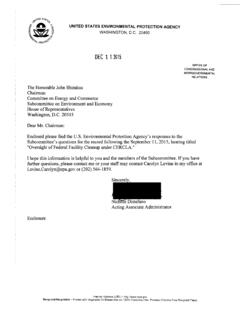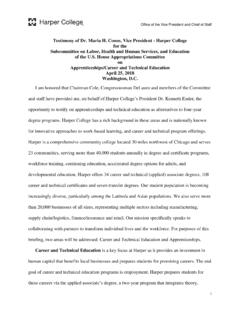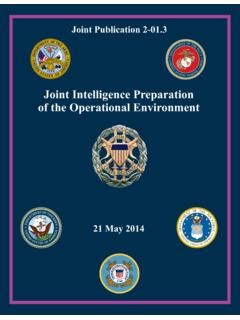Transcription of STATEMENT OF ADMIRAL PHILIP S. DAVIDSON, U.S. NAVY ...
1 STATEMENT OF. ADMIRAL PHILIP S. DAVIDSON, NAVY. COMMANDER, INDO-PACIFIC COMMAND. BEFORE THE HOUSE ARMED SERVICES COMMITTEE. ON INDO-PACIFIC COMMAND POSTURE. 10 MARCH 2021. INTRODUCTION. Chairman Smith, Ranking Member Rogers, and distinguished members of the Committee, thank you for the opportunity to appear before you to discuss the Indo-Pacific Region. The Indo- Pacific is the most consequential region for America's future and remains the Department of Defense's priority theater. This region contains four of the five priority security challenges identified by the Department of Defense and includes frequent natural and man-made disasters, the negative impacts of climate change, rapid population growth, and of course, disease and pandemics.
2 The Indo-Pacific accounts for 60 percent of the world's current Gross Domestic Product (GDP). and contributes more than two-thirds to the present global economic growth. Trade and investment in this dynamic region are vital to the security and prosperity of the United States and reflective in more than $ trillion in two-way trade with the Association of Southeast Asian Nations (ASEAN), serving as the number one destination for foreign direct investment (FDI). In 10 years, the region will host two-thirds of the world's population and two-thirds of the global economy. Our Nation's vision for peace and prosperity in a Free and Open Indo-Pacific continues to resonate in the region and serves as an important reminder to all nations that the remains committed to free and fair trade, shared access to global markets, good governance, and human rights and civil liberties.
3 The region's economic prosperity and security are inextricably linked and part of the competitive landscape. The greatest danger for the United States in this competition is the erosion of conventional deterrence. A combat-credible, conventional deterrent posture is necessary to prevent conflict, protect interests, and to assure our allies and partners. Absent a convincing deterrent, the People's Republic of China (PRC) will be emboldened to take action to undermine the rules- based international order and the values represented in our vision for a Free and Open Indo- Pacific. The combination of the PRC's military modernization program and willingness to intimidate its neighbors through the use, or threatened use of force, undermines peace, security, and prosperity in the region.
4 2. Indo-Pacific Command's approach for addressing Great Power Competition centers on advancing a Free and Open Indo-Pacific by focusing on four critical areas: 1. Increasing Joint Force Lethality 2. Enhancing Design and Posture 3. Strengthening Allies and Partners 4. Modernizing our Exercises, Experimentation, and Innovation Programs In 2019, I reported to this Committee we had lost a quantitative advantage and our qualitative advantage was shrinking across several domains as the People's Liberation Army (PLA) fields higher quality systems. However, with this Committee's efforts to establish the Pacific Deterrence Initiative (PDI), along with resourcing our advanced undersea warfare capabilities and 5th generation fighters, I am optimistic you have created the opportunity to Regain the Advantage, but we must remain diligent.
5 PDI provides the foundation for establishing a forward-deployed, defense-in-depth posture that defends our interests abroad, deters aggression, assures allies and partners, and provides flexible response options should deterrence fail. PDI also provides the requisite budget transparency and oversight to ensure resources are prioritized appropriately. Thank you for your continued support. On top of PDI support, investing in our most critical and resilient resource our people is a national security imperative. USINDOPACOM is staunchly committed to promoting the health and well-being of our teammates. In addition to providing necessary warfighting tools, we remain deeply focused on cultivating a safe environment for our DOD professionals to thrive, execute their mission, and fulfill their oath to the Constitution.
6 We must take deliberate action to protect and sustain the force to meet the demands of strategic competition. Indeed, our Defense- wide priorities dedicated to combating COVID-19, extremism, and sexual assault and sexual harassment within our force are at the foundation of our efforts to Regain the Advantage. For the past twelve months, protecting and sustaining joint force readiness began with our efforts to mitigate the effects of the COVID-19 pandemic. We have worked extensively with the local, 3. state, and national leadership to combat this contagion and successfully minimized the impact on USINDOPACOM's ability to perform its mission in the short term.
7 However, COVID-19 has had a moderate effect on the readiness and budgets of our allies and partners. We will continue to support their efforts to maintain readiness and minimize any further negative impact. USINDOPACOM conducted a Headquarters-wide Stand-Down to address extremism within the ranks of our force in line with guidance from the Secretary of Defense (18 Feb). The program included virtual training modules featuring subject matter experts, presentations by our most senior leaders, and facilitated small-group discussions to build awareness and help prevent actions associated with extremist behaviors that go against the fundamental principles of our oath.
8 The message provided a clear reminder that we are required to obey all lawful orders, support civil authorities to protect lives and property, and ensure public safety in accordance with the law. There is more to be done in our endeavor to eradicate extremism and the corrosive impact it has on our entire force. The senior leaders at USINDOPACOM will continue to host regular one-on- one listening sessions with volunteers from across the Headquarters to perpetuate this meaningful dialogue. We will capitalize on well-established, routine activities to broadly and frequently communicate/interact with our workforce to better educate our team about the scope of this problem and to develop sustainable solutions.
9 Indeed, operating in an environment free of discrimination, hate, and harassment while accomplishing our mission is paramount to our success. USINDOPACOM is fully committed to the prevention of sexual assault and sexual harassment something we absolutely must get right and cannot afford to fail. Over the past three years, we have improved our sexual assault and sexual harassment prevention efforts through a number of initiatives based on feedback received from several Command-wide surveys. To fully back-up this leadership imperative, I committed Headquarters resources and established a fully dedicated, on-site Sexual Assault Prevention Response (SAPR) program and a newly created Equal Opportunity (EO)/Equal Employment Opportunity (EEO) program.
10 This novel approach is unique to USINDOPACOM and it transforms the traditional design which relies on individual services to provide external SAPR and EO/EEO support to combatant command personnel into a more immediate, more insightful, and more involved response mechanism. As a result of these initiatives, we have built trust, credibility, and awareness in these vital programs throughout the 4. Headquarters. We continue to seek every opportunity to combat, prevent, and eliminate sexual assault, harassment, and violence to keep safe all those who keep America safe. For the future, combat credible deterrence depends on our ability to achieve four specific outcomes: 1) develop an agile and distributed Joint Force designed to deter and deny our adversaries of their objectives in the first and second island chains; 2) regain positional advantage by evolving our posture and balancing key capabilities across South Asia, Southeast Asia, and Oceania resulting in a more dynamic and distributed presence; 3) establish a network of compatible and interoperable allies and partners who are willing and able to protect their sovereignty from coercion.
